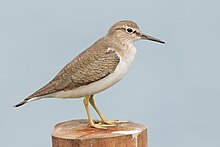Common sandpiper
| Common sandpiper | |
|---|---|

| |
| Adult, Laem Pak Bia, Thailand | |
| Scientific classification | |
| Domain: | Eukaryota |
| Kingdom: | Animalia |
| Phylum: | Chordata |
| Class: | Aves |
| Order: | Charadriiformes |
| Family: | Scolopacidae |
| Genus: | Actitis |
| Species: | A. hypoleucos
|
| Binomial name | |
| Actitis hypoleucos | |

| |
| Range Breeding Non-breeding Passage Possibly extant (non-breeding) Possibly extant (passage)
| |
| Synonyms | |
The common sandpiper (Actitis hypoleucos) is a small
Taxonomy
The common sandpiper was
Description
The adult is 18–20 cm (7.1–7.9 in) long with a 32–35 cm (13–14 in) wingspan. It has greyish-brown upperparts, white underparts, short dark-yellowish legs and feet, and a bill with a pale base and dark tip. In winter plumage, they are duller and have more conspicuous barring on the wings, though this is still only visible at close range. Juveniles are more heavily barred above and have buff edges to the wing feathers.[6]
This species is very similar to the slightly larger spotted sandpiper (A. macularia) in non-breeding plumage. But its darker legs and feet and the crisper wing pattern (visible in flight) tend to give it away, and of course they are only rarely found in the same location.[6]
Distribution and migration
The common sandpiper breeds across most of
Behaviour and ecology
The Common Sandpiper is usually encountered alone, occasionally in small groups, although larger flocks are sometimes formed around migration[8] or at breeding season roosts. It seldom joins multispecies flocks.[8] This species has a distinctive stiff-winged flight, low over the water.


Breeding
It nests on the ground near
Feeding
The common sandpiper forages by sight on the ground or in shallow water, picking up small food items such as insects, crustaceans and other invertebrates; it may even catch insects in flight.
Conservation
It is widespread and common, and therefore classified as a species of
Relationship to humans
In the Nukumanu language of the Nukumanu Islands (Papua New Guinea), this species is usually called tiritavoi. Another Nukumanu name for it, matakakoni, exists, but this is considered somewhat taboo and not used when children and women are around. The reason for this is that matakakoni means "bird that walks a little, then copulates", in reference to the pumping tail and thrusting head movements the Actitis species characteristically perform during foraging.[6][11]
References
- ^ . Retrieved 19 November 2021.
- ^ Linnaeus, C. (1758). "Tringa hypoleucos". Systema Naturae per regna tria naturae, secundum classes, ordines, genera, species, cum characteribus, differentiis, synonymis, locis (in Latin). Vol. Volume 1 (Tenth ed.). Holmiae (Stockholm): Laurentii Salvii. p. 149.
- ^ Illiger, J.K.W. (1811). Prodromus systematis mammalium et avium (in Latin). Berolini [Berlin]: Sumptibus C. Salfeld. p. 262.
- ^ Rasmussen, P., eds. (2021). "Sandpipers, snipes, coursers". IOC World Bird List Version 11.2. International Ornithologists' Union. Retrieved 22 November 2021.
- ISBN 978-1-4081-2501-4.
- ^ ISBN 0-395-60237-8.
- ^ VanderWerf, E.A.; Wiles, G.J.; Marshall, A.P.; Knecht, M. (2006). "Observations of migrants and other birds in Palau, April–May 2005, including the first Micronesian record of a Richard's Pipit" (PDF). Micronesica. 39 (1): 11–29.
- ^ ISBN 9780643097544.
- ^ Mann, C.F. (1991). "Sunda Frogmouth Batrachostomus cornutus carrying its young" (PDF). Forktail. 6: 77–78. Archived from the original (PDF) on 2016-03-04. Retrieved 2016-02-20.
- ^ "Species". Agreement on the Conservation of African-Eurasian Migratory Waterbirds (AEWA). Retrieved 14 November 2021.
- ^ Hadden, D.W. (2004). "Birds of the northern atolls of the North Solomons Province of Papua New Guinea" (PDF). Notornis. 51 (2): 91–102. Archived from the original (PDF) on 2020-01-14. Retrieved 2016-02-20.
External links
- Ageing and sexing (PDF; 5.5 MB) by Javier Blasco-Zumeta & Gerd-Michael Heinze
- Common sandpiper species text in The Atlas of Southern African Birds
- BirdLife species factsheet for Actitis hypoleucos
- "Actitis hypoleucos". Avibase.
- "Common sandpiper media". Internet Bird Collection.
- Common sandpiper photo gallery at VIREO (Drexel University)
- Audio recordings of Common sandpiper on Xeno-canto.
- Actitis hypoleucos in Field Guide: Birds of the World on Flickr
- Common sandpiper media from ARKive

